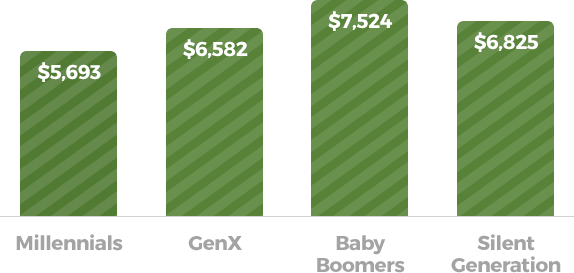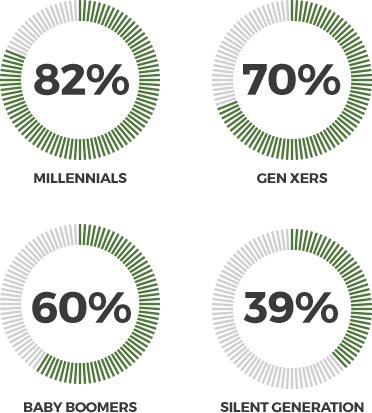Greetings,
The results of HomeAdvisor’s 2018 True Cost Survey are in, and it’s clear that we’re looking at another healthy year for home improvement projects and spending.
Interestingly, it’s also clear that the millennial generation is becoming increasingly important in this sector of the economy. Not only did millennial homeowners complete the most home projects per household in the last 12 months, but five in every six homeowners plan to spend as much or more on home improvements in the coming 12 months. What’s more, millennial homeowners are now twice as likely as baby boomers to tackle kitchen and bathroom remodels!
The reason is simple: Most millennials have had to compromise on the size and condition of their starter homes — with many purchasing older homes in need of repair just to be able to afford homeownership. Many of the millennials who did buy a home in the last few years are seeking to upgrade. But a lack of housing inventory, coupled with inflated home prices and rising mortgage rates, has them renovating their existing homes instead of selling and moving. Luckily, many have built up the equity to afford the cost of some improvements.
Of course, this phenomenon isn’t restricted to millennial homeowners. In fact, most homeowners report plans to remain in their existing homes, with half considering a remodel. And the majority of homeowners say they’re planning to spend as much or more on home improvements in the coming year — primarily on cosmetic enhancements such as painting, landscaping and remodeling.
In HomeAdvisor’s 2018 True Cost Report, I’ve detailed and provided some context around national home improvement trends and spending — particularly as they compare among generations — based on the findings of our annual True Cost Survey. Ultimately, I believe we’ll see continued vigor for home renovations, and increased home improvement spending, for many years to come. And when it comes to millennial influence, we’ve only just begun to scratch the surface
Happy reading,
BRAD HUNTER
Chief Economist, HomeAdvisor
Key Findings:
Current Home Improvement Trends
- Homeowners have spent an average of $6,649 on home improvements per household in the last 12 months.
- Millennials are more likely than any other generation to remodel any part of their homes — and they’re twice as likely as baby boomers to complete bathroom and kitchen remodeling projects.
- Millennials have completed the most home projects in the past 12 months — 72 percent, 42 percent and 18 percent more than the silent generation, baby boomers and Gen Xers, respectively.
- Baby boomers have spent the most money on home projects in the past 12 months — 32 percent, 14 percent and 10 percent more than millennials, Gen Xers and the silent generation, respectively.
Looking Ahead
- Homeowners are choosing remodeling over selling and moving. In fact, more than 80 percent plan on staying in their existing homes, and half of all respondents are considering a remodel.
- Homeowners cite improved aesthetics as their primary motivation for remodeling, followed by improved comfort and added value.
- More than half of homeowners say they’d like to purchase and personalize a fixer-upper home.
- Nearly two-thirds of American homeowners plan to spend as much money or more on home improvements in the coming 12 months over the past 12 months.
- Five in six millennials plan to spend as much or more on home improvements in the coming 12 months, with more than half of millennials expecting to spend more than they spent last year.
- Interior painting, landscape installation, bathroom remodeling, flooring installation, and exterior staining and painting projects top the list of projects homeowners are considering completing in the next 12 months.
Current Home Improvement Trends:
Remarkable Role Reversals
Home improvement continues to flourish, with homeowners spending an average of $6,649 on home improvements in the last 12 months. In past years, baby boomers have completed the most home projects and spent the most home improvement dollars. But HomeAdvisor’s 2018 True Cost Survey finds that, while baby boomers remain the biggest spenders, millennials have taken the lead in completing the most home improvement projects. Also interesting: Homeowners are completing more bathroom remodeling projects than kitchen remodeling projects. This is another reversal of a steady trend we’ve seen in recent years.
The Renovation Generation:
Millennials Make Their Mark
Millennial homeowners have completed more home projects per household in the last 12 months than homeowners in any other generation, surpassing the silent generation, baby boomers and Gen Xers by 72 percent, 42 percent and 18 percent, respectively. While this is a considerable shift from what we’ve seen in past years, it’s a shift we were expecting. And there’s a clear explanation for it happening now instead of later.
Twice as many millennials say they’re considering selling their home to buy a new one, compared with other generations.
And more than half of millennials say they want to move to get more space or upgrade to a nicer home. Most have had to compromise on the size and condition of their starter homes, and many have had to buy older homes in need of repair just to afford homeownership. Now that they’ve owned their homes for a few years, millennials are seeking better functionality and an improved aesthetic. But a low level of inventory on the Multiple Listing Services (MLS), coupled with inflated new home prices and rising mortgage rates, has many of them renovating existing homes instead of selling and moving. Many have now built up the equity to afford the cost of improvements, and they can use that equity to spruce up their homes and use the space more efficiently.
To that end, millennials report a greater tendency than any other generation to remodel and personalize their homes. Not only are they twice as likely as baby boomers to remodel their kitchens and bathrooms, but they also report a greater tendency to build a deck or porch and paint a home exterior. Of course, while millennials have a higher propensity to tackle these improvements, they don’t spend nearly as much as baby boomers to complete them. In fact, baby boomers, who’ve had more time to build equity and larger salaries, have outspent millennials by 32 percent over the last 12 months on home projects. What’s more, baby boomers plan to spend 77 percent more on kitchen remodeling projects in the next 12 months than millennials. And they expect to spend 46 percent more on basement remodels.
Home Improvement Spend by Generation
“Baby Boomers Have Outspent Millennials on Home Projects by 32 Percent in the Last 12 Months”


Popular Projects:
Bathroom Remodels Get a Boost
HomeAdvisor’s research shows that bathroom remodels will continue to be more popular than kitchen remodels. In fact, almost one-quarter of homeowners say they’re planning for a bathroom remodel in the next 12 months, compared to 15 percent of homeowners planning for a kitchen remodel. Adding or upgrading creative lighting, flooring, cabinets, shower doors/enclosures and tile are popular tasks. Many homeowners also include luxury touches like multiple shower heads and built-in audio speakers for extra entertainment and enhanced relaxation.
Interestingly, millennials are twice as likely as baby boomers to complete a bathroom remodel. Of course, baby boomers plan to spend as much as 51 percent more in the next 12 months on bathroom remodeling projects, and the scope of these projects will vary by age group as well. Over the next 12 months, millennials envision spending an average of $1,896 on bathroom work, while other generations plan to spend around $500 to $1,000 more.
Over the past 12 months, HomeAdvisor has fielded homeowner requests for handyman services more than any other project, followed by plumbing and electrical repairs, cleaning and lawn services, and appliance and roof repair. The popularity of repair and maintenance projects, peppered among larger-scale upgrades such as bathroom remodels, exterior painting, landscape installations and kitchen remodels, is indicative of the millennial influence and the trend towards continued home improvement growth. More homeowners are choosing to remain in and improve their existing homes rather than sell and move into new homes. And, depending on the age and condition of their home, as well as their own age and economic situation, they’re making modifications both out of necessity and a desire for aesthetic and lifestyle improvements.
Looking Ahead:
Three Signs Point to Ongoing Growth in Home Improvement
Over the past few years, we’ve seen steady growth in home improvement resulting from increased home values, increased homeowner equity and increased consumer confidence in a recovering economy. Going forward, we’ll likely see home values and equity continue to fuel home improvement growth, but in a much different way — particularly as older homeowners complete more accessibility improvements and millennial influence continues to grow in the home improvement sector.
1
Homeowners are choosing improving over moving.
Much of the strength in home improvement can be attributed to an unusually low supply of housing for sale, which is driving up home prices and frustrating would-be homebuyers. The number of homes for sale in markets across the country was already low a year ago, and the supply has fallen further short in 2018 — particularly in homes priced under $200,000, for which new listings have declined by 12 percent, according to Realtor.com1. What’s more, home prices are up 8 percent year over year.
The upshot is that many people who would ordinarily want to move to a different home are making the decision to stay put and improve or repair the home they already have. In fact, 84 percent of homeowners report having no plans to sell their current primary residence within the next 12 months and half of homeowners are considering a remodel — despite the fact that nearly two-thirds would actually prefer to purchase a new home that meets their needs.

84 percent of homeowners report having no plans to sell their current primary residence within the next 12 months.
The results from our True Cost Survey show that relatively few homeowners plan to move out of necessity — for job relocation or economic reasons, for example. Rather, homeowners considering a home sale are seeking more space and a nicer home, which can largely be attained with home improvements and projects like garage and basement conversions, closet system installations and purposeful home additions. If they were to move, more than half of homeowners say they’d consider purchasing a fixer-upper home — primarily to get a lower price and make the space their own.
“More than half of homeowners say they’d consider purchasing a fixer-upper home — primarily to get a lower price and make the space their own.”
The lack of homes available for sale affects millennials, in particular, because the inventory shortage is so acute in the under-$200,000 price point. A millennial who purchased a basic starter home a year or two ago may now be looking to upgrade. And they may have trouble finding a home they can afford. Similarly, baby boomers who bought five- and six-bedroom homes when they were raising kids may have expected to sell those homes and buy smaller homes. And many of those homeowners are staying in homes larger than they need because the demand for (and potential sales price of) their homes is relatively low.
Popular Reasons Homeowners Want to Buy a New Home:
 Upgrade to a
Upgrade to a
nicer home Need more
Need more
space Be closer
Be closer
to family Tired of
Tired of
current home Moving for a
Moving for a
better commute
2
Homeowners plan to spend more — largely on remodels.
Half of homeowners report plans to complete additional home improvements in the next 12 months, also reporting that they plan to spend as much as they’ve spent in the last 12 months on home projects — or more. In fact, 82 percent of millennials, 70 percent of Gen Xers and 60 percent of baby boomers anticipate spending as much or more on home projects, compared with just 39 percent of the silent generation. And more than half of millennials say they expect to spend more than they spent last year.
Homeowners Planning to Spend as Much or More in the Next 12 Months

Interestingly, while we’ve seen a solid mix of repair, maintenance and improvement projects rise to the top of homeowners’ to-do lists over the past 12 months, homeowners report plans to spend primarily on cosmetic enhancements in the coming 12 months — with interior painting, landscape installation, bathroom remodeling and new flooring topping the list of planned projects. This falls in step with the fact that homeowners cite an improved aesthetic, improved comfort and added value as their primary reasons for completing remodeling projects — 35 percent, 25 percent and 19 percent, respectively.
Of course, the focus on remodeling projects further reflects the strong personal balance sheets of the baby boomers and the increasing influence of millennials. Many people in their 50s and 60s have accumulated a great deal of new wealth recently in the form of homeowner equity and in the value of their investment holdings. This has given them the financial wherewithal and the confidence to indulge in some new luxuries. Luxury and discretionary home upgrades account for a larger share of total home improvement expenditure than they did 10 years ago2.
With regard to the millennials, many had to buy neglected homes just to be able to afford homeownership. Much of the neglect in those older fixer-upper starter homes was cosmetic. Now, with rapidly rising home values spurring sudden equity in those homes, young homeowners are making improvements to beautify and personalize their spaces. Home improvement expenditure levels are 50 percent higher2 among owners of older homes than owners of homes built after 2010. And, of course, people with significant home equity are feeling financially secure enough to tap into that equity for upgrades. Looking further into the future, millennials will see a significant increase in their share of home improvement spending; millennials3 are already buying one-third of the homes sold in the United States.
“In many cases, there is a significant difference between what homeowners anticipate spending on planned projects and what homeowners report spending on those projects, according to HomeAdvisor’s True Cost Guide.”
It’s worth noting that, in many cases, there is a significant difference between what homeowners anticipate spending on planned projects and what homeowners report spending on those projects, according to HomeAdvisor’s True Cost Guide. In many cases, actual costs may exceed anticipated costs by two-, three- and even four-fold or more.
3
Rising interest rates are poised to play a bigger role in decision-making.
Currently, recent tax changes and rising interest rates are not significantly impacting homeowners’ decisions regarding home improvements and home sales and purchases, according to the findings of our True Cost Survey. In fact, more than two-thirds of homeowners say these changes make them neither more nor less likely to complete a major home improvement project or sell and purchase a primary residence in the next 12 months. However, certain generations appear to be more affected — with more than 30 percent of millennials and Gen Xers saying they’re less likely to sell and purchase a home as a result of rising interest rates.
Looking a few years into the future, we anticipate rising mortgage rates to have a greater impact on homeowners’ decisions regarding home sales and purchases. We expect that, unless they have to move for reasons related to job relocation or family, more people will consider staying where they are to keep their current, locked-low mortgage rate and avoid borrowing at a higher rate to make a new purchase. Faced with higher monthly mortgage payments, homeowners will become increasingly hesitant to sell their current primary residence to purchase a new home. That means they’ll continue to improve instead of move. And that in itself will facilitate continued growth in home improvement.
The results of this study have confirmed that several factors are converging to boost home improvement activity. At the top of the list is mobility: People are showing a greater tendency to stay in the home they already have and improve it rather than moving. Secondly, homeowners are increasing their expected average expenditure. The doubling of homeowner equity over the past six years has given people the financial wherewithal, and the confidence, to make investments in their homes. This is showing up now as homeowners take on projects that they may have previously put off, or as they indulge themselves in discretionary upgrades that they can now afford.
The biggest changes are happening at the extreme ends of the age spectrum. People in their 60s are adding touches of luxury and convenience, while people in their 30s are using their savings and newfound home equity to make their homes more efficient, while improving the aesthetics and infrastructure of their homes.

 Upgrade to a
Upgrade to a

